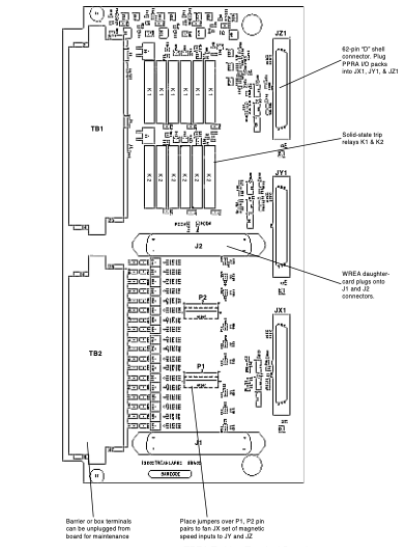1605684733906584286.jpg)
World Of Controls understands the criticality of your requirement and works towards reducing the lead time as much as possible.
IS210TREAS1A - Aero Derivative Turbine Emergency Trip Board is available in stock which ships the same day.
IS210TREAS1A - Aero Derivative Turbine Emergency Trip Board comes in UNUSED as well as REBUILT condition.
To avail our best deals for IS210TREAS1A - Aero Derivative Turbine Emergency Trip Board, contact us and we will get back to you within 24 hours.
SPECIFICATIONS:
Part Number: IS210TREAS1A
Manufacturer: General Electric
Series: Mark VIe
Product Type: Aero Derivative Turbine Emergency Trip Board
Function: Emergency Trip Terminal Board
Number of inputs: 6
Number of outputs: 3
Technology: Surface Mount
Size: 33.0 cm high x 17.8 cm
Temperature: -30 to +65�C
Repair: 3-7 Days
Weight: 2.00 lbs
Country of Origin: USA
Availability: In Stock
Manual: GEH-6721L
FUNCTIONAL DESCRIPTION:
IS210TREAS1A is an Aero Derivative Turbine Emergency Trip Board manufactured and designed by General Electric as part of the Mark VIe Series used in distributed control systems. As a component of the Mark* VIe system, the Aero derivative Turbine Emergency Trip (TREA) terminal board and WREA option card work with PPRA turbine I/O packs. The following are the inputs and outputs:

Fig 1: TREA Turbine Terminal Board
INSTALLATION:
The WREA should by default be mounted to the TREA terminal board when it is received from the factory. Use the steps below to replace the WREA if the board needs to be taken out to service the TREA fanning jumpers.
Voltage detection, trip contact inputs, and relay outputs are connected to the I/O terminal blocks TB1 for the H1 and S1 board variations. TB2 is wired with passive pulse rate pick-up devices. Each block has 24 terminals that may accommodate wires up to #12 AWG and are secured with two screws. Each terminal block is followed by a shield termination strip connected to the chassis ground.
Voltage detection, trip contact inputs, and relay outputs are attached to the I/O box terminals at the top of the board for the H3 and S3 board variations. The lower terminals are coupled with passive pulse rate pick-ups. Each terminal accepts a single #12 AWG wire and plugs it into a header on the TREA board.
OPERATION:
Three PPRA I/O packs placed directly on the TREA board are intended to be used with it. A self-contained emergency trip function is therefore formed by the TREA/WREA/PPRA assembly. Only three PPRA I/O packets are necessary for TREAH1A, S1A, H3A, and S3A plus WREA to operate properly. Operation with a single or twin pack is not feasible. In systems with a single controller, the controller R network, S network, and T network should be linked to the PPRA on the JX1 connection, JY1 connector, and JZ1 connector, respectively. Keep in mind that one controller is the source of all three networks. The R network of the controller should be connected to the PPRA on the JX1 connector, the S network to the PPRA on the JY1 connector, and both the R and S networks to the PPRA on the JZ1 connector in systems with dual controllers.
CONFIGURATION:
The fanning of the X channel speed inputs to the Y and Z PPRA I/O packs is selected by jumpers JP1 and JP2. These jumpers are required for TREA and WREA operations with PPRA. The six-speed repeater output circuits' output behavior is configured using the WREA jumpers JP1 through JP12. RS-232 signal level (the default) and RS-485 signal level can be chosen for the repeater output using the jumpers JP1 through JP6. While JP4�JP6 configure repeaters for PR4�PR6, JP1�JP3 configure the repeater outputs for PR1�PR3. When used with PPRA, jumpers JP7 through JP12 should stay in the PR1 through PR6 positions by default.
WOC has the largest stock of GE distributed control systems replacement parts. We can also repair your faulty boards and supply unused and rebuilt boards backed up with a warranty. Our team of experts is available round the clock to support your OEM needs. Our team of experts at WOC is happy to assist you with any of your automation requirements. For pricing and availability on any parts and repairs, kindly get in touch with our team by phone or email.
FREQUENTLY ASKED QUESTIONS:
What is GE Mark VIe IS210TREAS1A?
IS210TREAS1A is an Aero Derivative Turbine Emergency Trip Terminal Board developed by GE and used in distributed control systems.
How to Check Price and Availability For IS210TREAS1A?
Please Contact World of Controls FZE for sales at +1 609 385 1231 or Request a Quote.
How are boards packaged for shipment from WOC?
Parts are placed in antistatic packets and securely packed in ESD boxes cushioned with ESD Foam designed to safeguard electrical components.